Yesterday’s live coverage of the Ukraine conflict can be found here. An archive of our liveblogs can be found here. For an overview and analysis of this developing story see our latest podcast.
Please help The Interpreter to continue providing this valuable information service by making a donation towards our costs.
View Ukraine: April, 2014 in a larger map
For links to individual updates click on the timestamps.
For the latest summary of evidence surrounding the shooting down of flight MH17 see our separate article: Evidence Review: Who Shot Down MH17?
After two days of intense artillery and infantry battles, the Russian-backed fighters have failed to retake Donetsk Airport from the Ukrainian military. Today there appears to have been less infantry fighting, but perhaps even more shelling, as the Russian-backed militants licked their wounds.
A report from the Press Center of Ukraine’s ATO (Anti-Terror Operation) says that the Ukrainian “cyborgs” repelled another major attack this morning. The “terrorists” reportedly then retreated and fired on the new terminal and logistics tower with mortars and tanks. The defenders reportedly kept their positions thanks to strong fire support.
The tone of that report was highly optimistic, saying that the Ukrainian forces had even restored some of the damaged infrastructure at the airport.
A report published by Unian.info four hours before the ATO report, citing a soldier in the 80th airmobile birgade, said that the Russian-backed fighters had taken one third of the new terminal yesterday and had largely destroyed the rest with tanks and artillery.
Still, it seems Ukraine is still in control of the airport for now.
There was less fighting today but battles were still more intense than they have been in months, and now a video claims to show a very small part of it. While we were searching for a weather report from Donetsk we found this, reportedly showing separatist militants taking fire near a weather station (Wikimapia has this location labeled as a radar station).
As you can see, this position offers little cover and is just north of Donetsk airport. The soldiers in this video are essentially surrounded on two sides.
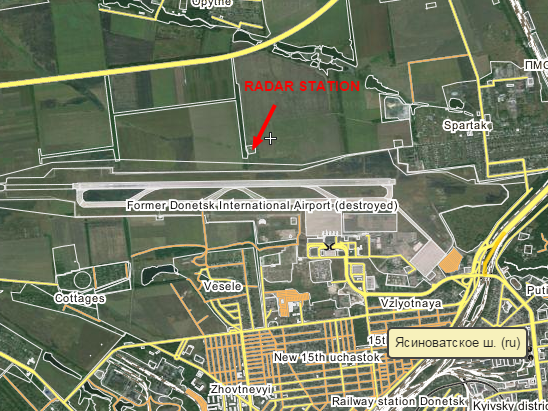
Meanwhile, LiveUAMap has shared this video, uploaded just an hour and a half ago to Youtube (20:39 GMT) which reportedly shows outgoing Grads fired from Donetsk today. While we can’t verify the location of the video, there are no known copies of this video which predate this video.
The OSCE’s Special Monitoring Mission (SMM) has released their spot report from Volnovakha where at least 13 people have now died after a bus was hit by shrapnel. The OSCE report confirms what we have already deduced: the bus was struck by shrapnel from a Grad rocket.
The SMM arrived at the location of the incident at 17:45hrs and witnessed the removal of two of the dead passengers from the bus. The bus had shrapnel damage consistent with a nearby rocket impact, estimated by the SMM to be 12-15 meters from the side of the bus. The SMM visited the Volnovakha hospital where the staff confirmed that ten persons on the bus were killed instantly, while two died later in the hospital. Another 17 passengers were injured.
Note that the death toll has since risen to 13.
The Interpreter has analyzed alternative theories, including that a claymore mine did this damage. After watching videos of claymore mine explosions, the result does not seem consistent with damage from a mine. The holes in bus are simply too large for a claymore, and too small for a larger mine. Also, the damage to the surrounding area does not seem to match this theory. As you can see in one video where a mine targets an unarmored trailer, the effectiveness of the mine drops of significantly even 3 meters away. OSCE now says that the explosion was 12-15 meters away.
Of course, the most compelling evidence is in the form of video, posted by The Interpreter earlier, showing that the entire area was hit by many large explosions, likely from a multiple-launch-rocket-system like the Grad.
The Russian media is still fixated on the possibility that this damage was the result of a mine, and the OSCE appears to be too diplomatic to officially rule that out until an investigation has been held, though their new report makes no reference to a mine.
The OSCE has also agreed to investigate the incident in cooperation between a representative of Ukraine and a member of the Russian Armed Forces who will be representing the separatist leadership:
Following a proposal from the SMM, the Ukrainian Major-General and Head of the Ukrainian side to the JCCC and the Russian Federation Major-General, representative of the Armed Forces of the Russian Federation to the Joint Centre for Control and Co-ordination (JCCC) and the “Donetsk People’s Republic” (DPR) leadership have agreed to conduct a joint investigation led by the JCCC. In parallel, the SMM will continue its observations and establish its own findings regarding the incident.
— James Miller
As of right now a significant amount of Russia’s natural gas travels through Ukraine and into Europe. 63 billion cubic meters of gas travels through this line each year. This supply has been threatened by the conflict in Ukraine, however. In December, Putin announced that Russia was scrapping plans to build the South Stream pipeline, a pipeline which was supposed to bypass Ukraine. TASS reports:
The South Stream gas pipeline worth €15.5 billion was intended to pump 67 billion cubic meters of Russian natural gas to Europe annually. The pipeline’s underwater section 900 km (559 miles) long was intended to run along the bed of the Black Sea from the Russkaya compressor station on the Russian shore to the Bulgarian coast.
Russian President Vladimir Putin announced on December 1 that the project to build the South Stream gas pipeline was closed due to the European Union’s unconstructive approach to cooperation in that sphere, including Bulgaria’s decision to stop the construction of the pipeline’s stretch on its territory.Instead, Russia will build a gas pipeline to Turkey where a gas hub on the border with Europe will be created, Putin said.
Today, however, Gazprom CEO Alexei Miller has announced that within several years no gas will be shipped through Ukraine. Instead, Russia will construct the Turkey Stream pipeline, shifting that supply through Turkey, and if Europe wants that gas it will need to build a pipeline along the border of Greece and Turkey in order to receive that gas. The Kyiv Post reports:
“They have at the most a few years for this. It’s a very, very tight schedule. In order to meet the deadlines, efforts to build new trunk pipelines in EU countries must begin right now, otherwise that gas will end up on other markets,” Miller said.
Business Standard is running a related headline, “Europe at risk of being cut off from Russia :Gazprom.” The article focuses on warnings from Miller that transit supplies through Ukraine, even in the short term, are at risk:
“Ukraine, due to financial difficulties, was not able to buy the necessary volume of Russian gas in November and December last year and significantly depleted its reserves of gas in underground storage,” Miller said.
Gazprom said for its part that it had met its obligations on supplies to Ukraine under a gas accord reached in November in Brussels but that Ukraine was not complying with its terms.
Ukraine’s state gas company Naftogaz “is acquiring gas in lower volumes than in the Brussels accord,” Gazprom complained.
Ukraine is taking gas out of its underground stores at a rapid rate, leaving supplies that are “not enough to reliably get through the winter period,” Gazprom said in a statement.
While Gazprom’s warning that Ukraine does not have enough gas is likely accurate, Miller seems to be sending a different message – that Europe needs to lessen its dependency on Ukraine.
It also bears noting that at various times in the last several months, Russia has threatened European countries, saying that if they reverse gas flow into Ukraine in breech of any negotiated deal with Russia, then their own gas supplies could be cut off.
— James Miller
Liveuamap reports on accounts of a rebellion within the Russian-backed fighters of the “Donetsk People’s Republic” (DNR) in crime.in.ua.
After the latest storming of the Donetsk Airport, during which Russian paratroopers and Chechen police suffered major losses, there was a “settling of scores,” says crime.in.ua.
There have been a number of reports of Chechen police from the Interior Ministry fighting in Ukraine.
Blogger Oleg Yarchuk, who often publishes intercepts of Russian military radio communications, has the report of the killing of a Russian officer from Ulyanovsk:
Area of Donetsk. Emergency. For your information, as a result of arguments that erupted over hostile personal differences, an officer of the combined shock battalion of the Chechen Republic Interior Ministry (ChRMVD), an officer of the 31st Guards Air Assault Brigade of the Airborne Troops (unit 73612 in Ulyanovsk–Ed) was shot dead. Asking for instructions for immediate transfer of the combined strike battalion of the ChRMVD.
Further reports indicate that the Kadyrovites, as Chechen fighters loyal to Chechen President Ramzan Kadyrov are known, went to the Donetsk State Administration for further confrontations with Prime Minister Aleksandr Zakharchenko.
Blogger Zloy Odessit [Angry Odessian] has an account translated by The Interpreter:
The “topic of the day” – the high-spirited battlers for the Russian World didn’t like the fact that they got their schawarma stuffed yesterday [were defeated–The Interpreter], and several Orthodox were taken captive. They demand that the so-called DNR chief make a deal with the Cyborgs [Ukrainian forces at the airport–The Interpreter] on exchange of POWs.
It will be interesting to observe how this situation turns out; in fact with this state of affairs, yesterday clearly it was no joke to pull the tail of the Kadyrovites. Really, there haven’t been such losses for the mercenaries since the May shooting of the seps at the Airport. Then the entire Russian Caucasus resounded with the wails at funerals.
Russian independent press reports at the time indicated there were a large number of Chechens and others from the North Caucasus among the 40 or so killed at the airport.
Yesterday, Ukrainian forces took two Chechen Interior Ministry officers as prisoners of war, crime.in.ua reported, citing Dmitry Tymchuk.
We have been unable to confirm these reports.
Earlier today, Leonid Matyukhin, a press officer at the Ukrainian military’s ATO headquarters, told reporters at a briefing in Kiev that Russian-backed forces had shelled targets near Donetsk Airport with TOS-1 Buratino MLRS on the night of January 13.
According to Matyukhin, the outskirts of Vesyoloye, which lies just between Donetsk Airport and the city proper, were shelled with the 220 mm thermobaric weapons.
This would be the first time such weapons were reported as being used in Ukraine, though there have been unverified rumours in the past.
The TOS-1 Buratino is a self-propelled multiple-launch rocket system (MLRS) firing rockets armed with thermobaric warheads, which disperse fuel throughout the air on impact before detonating, using environmental oxygen as their oxidizing agent.

Image from Wikipedia
Such warheads, also seen on the RPO-A Shmel portable rocket launcher, have a devastating effect on confined spaces or targets hiding in ruined buildings as they not only create huge fireballs and devastating pressure waves, but burn up the air around the impact site, creating a vacuum and asphyxiating those hiding in bunkers or basements.
Buratinos were put to use with devastating effect during the Second Chechen war.
Buratinos are not in Ukraine’s arsenal. No video or photographic evidence of the presence of Buratinos inside Ukraine has emerged so far.
Both last night and tonight, huge volleys of artillery and rockets have rained over Donetsk Airport and the surrounding area.
Images and video from tonight do indicate the use of extremely powerful weaponry, though we cannot say what type:
The pattern on each blast is distinctive: a huge flash is followed by a dense fireball that takes a few seconds to subside.
Meanwhile, freelance journalist Oliver Carroll, who is in the area, reported:
This is a screen capture from the live video feed facing Donetsk Airport, held by the Ukrainian military taken just minutes ago. It’s very hard to tell the range of flashes like this, especially when the sky is not totally clear, but our best guess is that this flash is an artillery shell landing right near the terminal buildings on the airport.
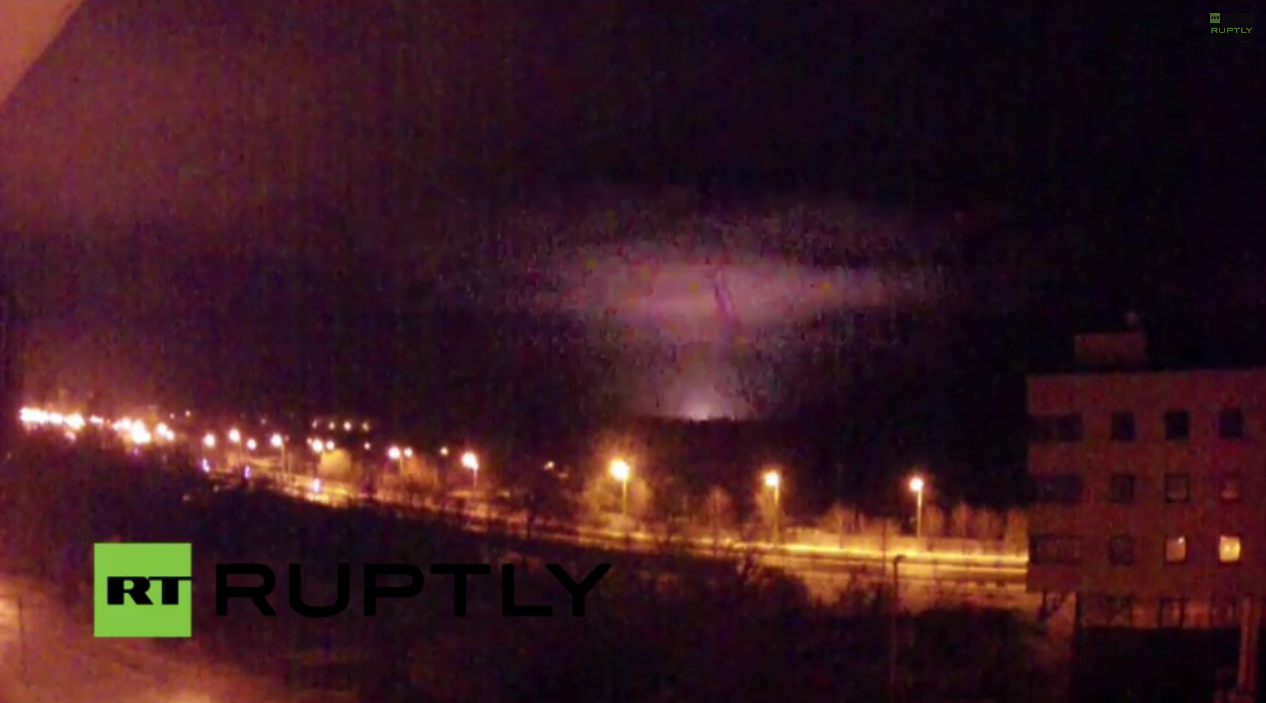
Further west:
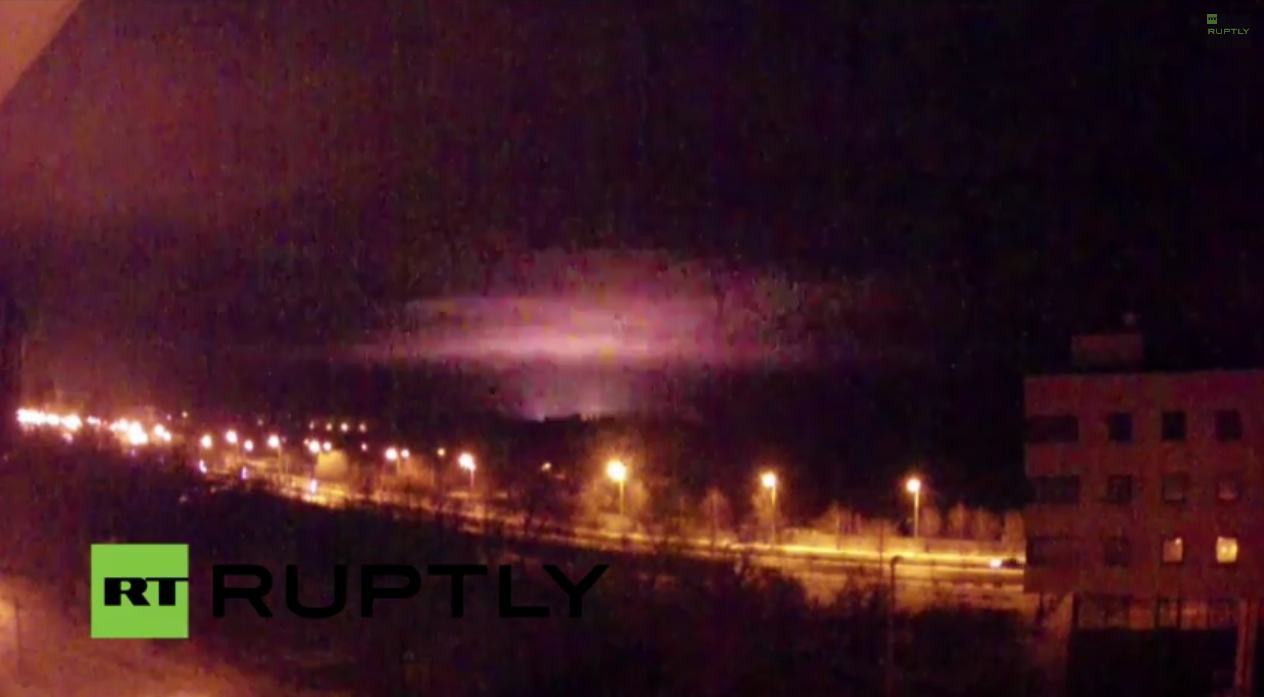
A series of massive fireballs:
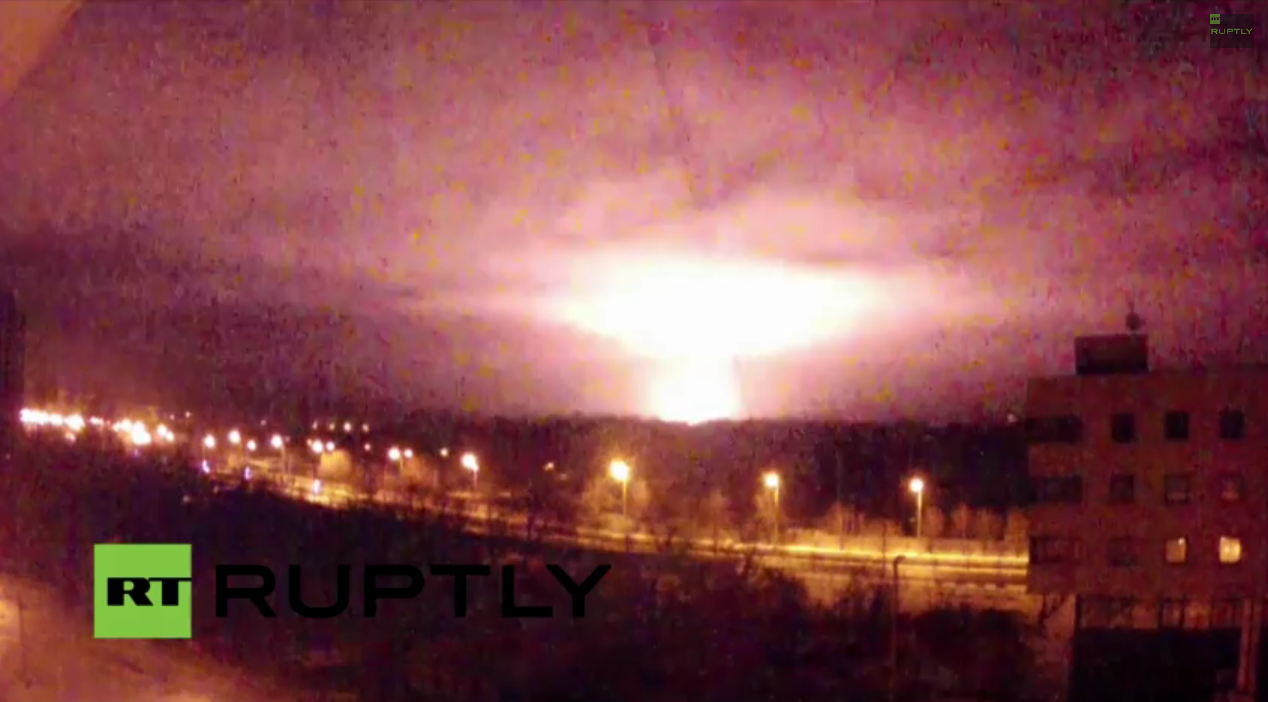
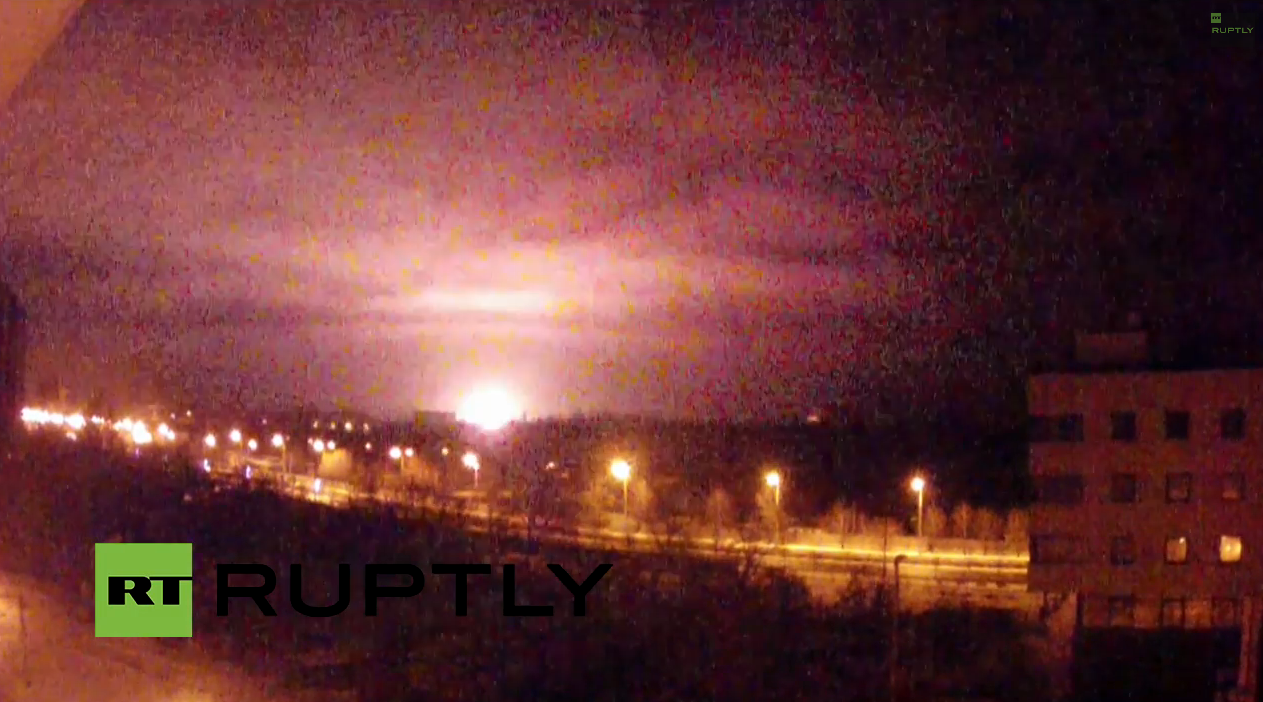
There are reports today that the Russian-backed fighters are using the TOS-1a Buratino multiple launch rocket system, a far more powerful weapon than the Grad rockets we’re used to seeing used in this conflict. We are currently tracking this story and will update soon.
The video does not actually show the bus because the camera is pointing in a different direction, but as we can see below, this is the right location. The bus is off to the bottom right (south), just out of frame:
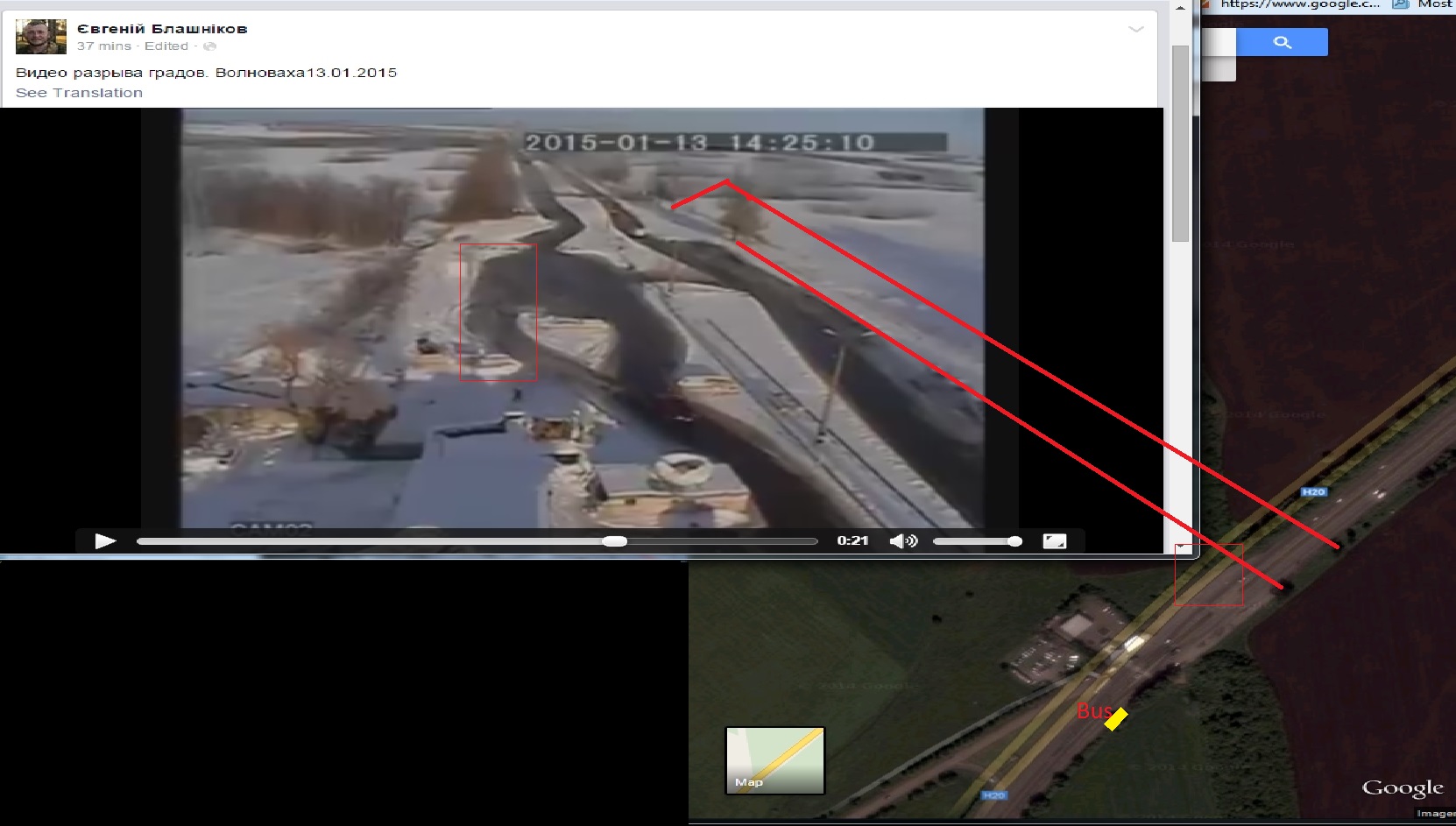
This is a screenshot from the original video showing the aftermath [WARNING – GRAPHIC] where you can see that there are several tall polls, one of which we’ve marked because the camera may be attached to it.
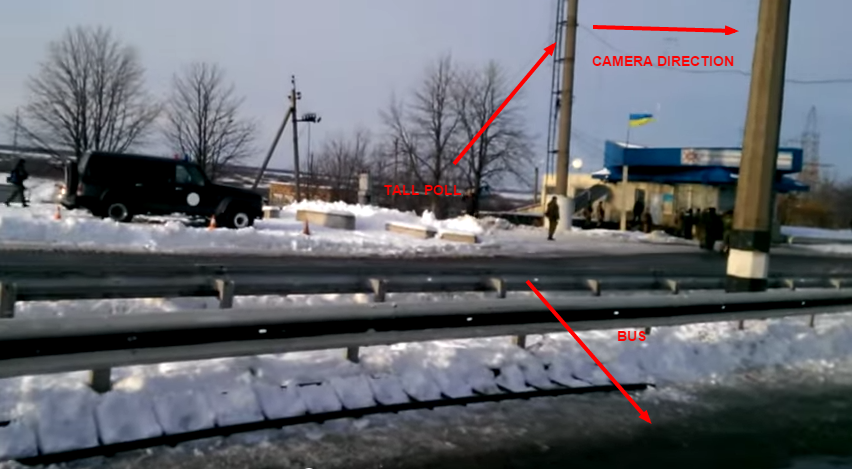
While the bus is not in the frame, we do see evidence of the explosion that hit the bus. Look at the following frames. In this frame the explosions have just started to hit the road. Notice the shadow of trees on the right of the road:
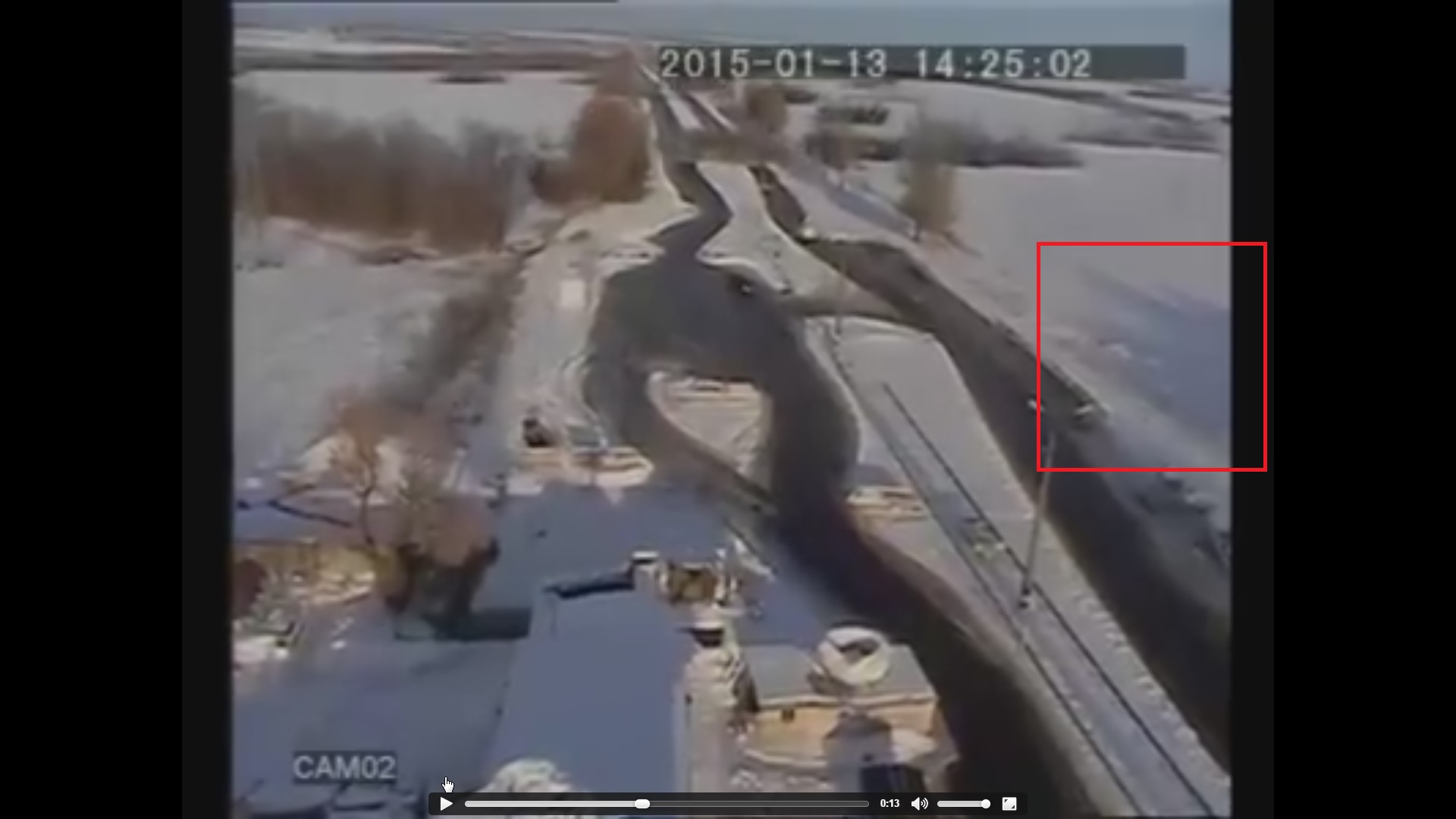
Seconds later, after more explosions, the shadow grows as if there is a cloud of smoke rising from just to the right of the frame — which is where the bus is:
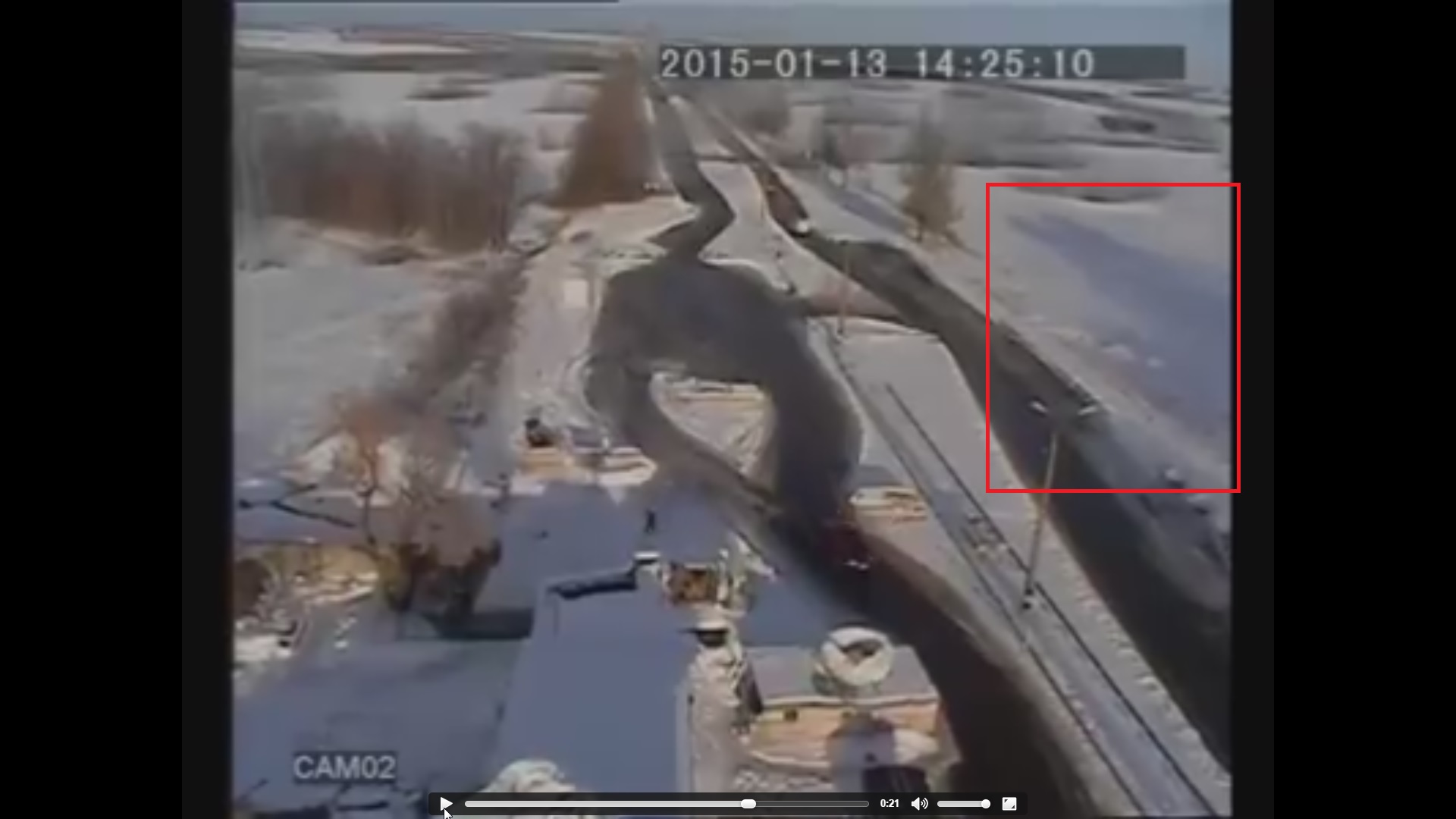
As you can see, several other cars nearly get hit by the tremendous number of explosions. Blogger Dajey Petros has marked the explosion sites:
This matches with reports published by Novaya Gazeta today (translated by The Interpreter’s Catherine A. Fitpatrick):
The prosecutor’s office of the Donetsk Region has characterized the shelling of the bus as a terrorist attack, placing the blame on DNR forces. According to information from the prosecutor’s office, the separatists carring out “a targeted strike with the use of the Grad system of explosive volley fire, using more than 40 shells.” Vyacheslav Abroskin, head of the police of the Donetsk Region controlled by the central Ukrainian authorities, had stated that the separatists were involved in the tragedy.
[…]
“The bus was traveling from Zlatoustovka to Donetsk,” a local resident told Novaya. “The last Ukrainian checkpoint was at Volnovakha. Further on are Ukrainian positions. But then Elenovka begins and immediately after that there’s a DNR checkpoint near Dokuchayevsk, where the DNR positions are located — there are artillery and Grads there. The direct distance from Dokuchayevks to Volnovakha is 20 kilometers.”
UPDATE: A different, longer version of the same film actually pans over and shows the bus, thus putting to rest the question of whether this is the right location.
In the time it took to write this update, another outgoing Grad volley was heard. Rocket attacks are escalating in volume as the sun is setting in Donetsk.
— James Miller
Serbia’s
Foreign Minister Ivica Dacic, the new chair-in-office of the
Organization for Security and Cooperation in Europe (OSCE), condemned the shelling of the bus yesterday, January 14 in Volnovakha, Ukraine in which 12 civilians were killed and 16 were wounded:
“I condemn in the strongest terms this attack on innocent passengers.
I am appalled by this incident and its tragic outcome, and express my
deepest sympathy to the families of the victims.”
“This incident comes as the situation in the east of the country has
significantly deteriorated and I call on all sides to immediately halt
the use of force, exercise restraint, return to negotiating table and
implementing both the letter and the spirit of the Minsk documents.”
“I am following the situation closely through reports from the OSCE
Special Monitoring Mission to Ukraine, and I urge all sides to allow for
the safe and unhindered access of OSCE monitors to all areas so that
they can do their job.”
Yesterday, Ambassador Ertugrul Apakan, OSCE’s chief monitor in Ukraine called upon all sides to exercise maximum restraint in eastern Ukraine in a press statement:.
Over the past 24 hours the situation has significantly deteriorated,
especially near the Donetsk airport; more civilian casualties have been
reported elsewhere.
The OSCE’s Short-Term Monitoring Mission has not yet released the report for yesterday; it’s last report was for January 12.
UNIAN reports that the office of the governor of the Lugansk region, Hennadiy Moskal, has announced that the town of Schastye and its surrounding villages have been left without gas or heating after heavy shelling by Russian-backed forces during the night ruptured a gas pipeline.
Due to the rupture, a supply valve at the gas distribution station in Schastye was shut off. Repair teams are at work on the pipeline and hoped to have supplies back online within a few hours, assuming there was no further shelling.
— Pierre Vaux
The United National Security Council (UNSC) has issued a presidential
statement regarding the shelling of the bus in Volnovakha yesterday
January 13, killing 12 and wounding 16. The Interpreter has obtained a copy:
The members of the Security Council condemned in the
strongest terms the killing of eleven and injuring seventeen civilians,
among them women and children, as a result of shelling of a passenger
bus in Volnovakha, Donetsk region, on 13 January 2015.
The members of the Security Council expressed their deep sympathy and condolences to the families of the victims.The
members of the Security Council underlined the need to conduct an
objective investigation and bring perpetrators of this reprehensible act
to justice.The members of the Security Council underlined the
need for strict observation of the Minsk protocol of 5 September and its
implementing memorandum of 19 September.
The death toll now stands at 12 today.
The statement was organized by the current president of the
monthly-rotating UNSC, Chile’s Ambassador Cristián Barros Melet. It is
not a resolution of the UNSC, as has been widely reported.
— Catherine A. Fitzpatrick
Mariupol news site 0629.com.ua reports that Vladimir Vivat, a press officer a the Ukrainian military headquarters in Mariupol, has told them that Russian-backed forces have mounted three attacks on Ukrainian positions in the area this morning.
According to Vivat, Ukrainian military positions near Nikolaevka came under two rounds of fire from automatic grenade launchers.
The first round came between 8:03 and 8:09 and the second from 8:25 to 8:29 (local time = GMT+2).
At 9:50 Ukrainian troops near Pavlopol came under mortar fire.
Vivat said that there were no Ukrainian military casualties. Neither were any civilian casualties reported by residents in Pavlopol.
The head of the village told 0629:
“The shells flew over our heads in the direction of Orlovskoye.”
Here is a map highlighting the locations referred to.
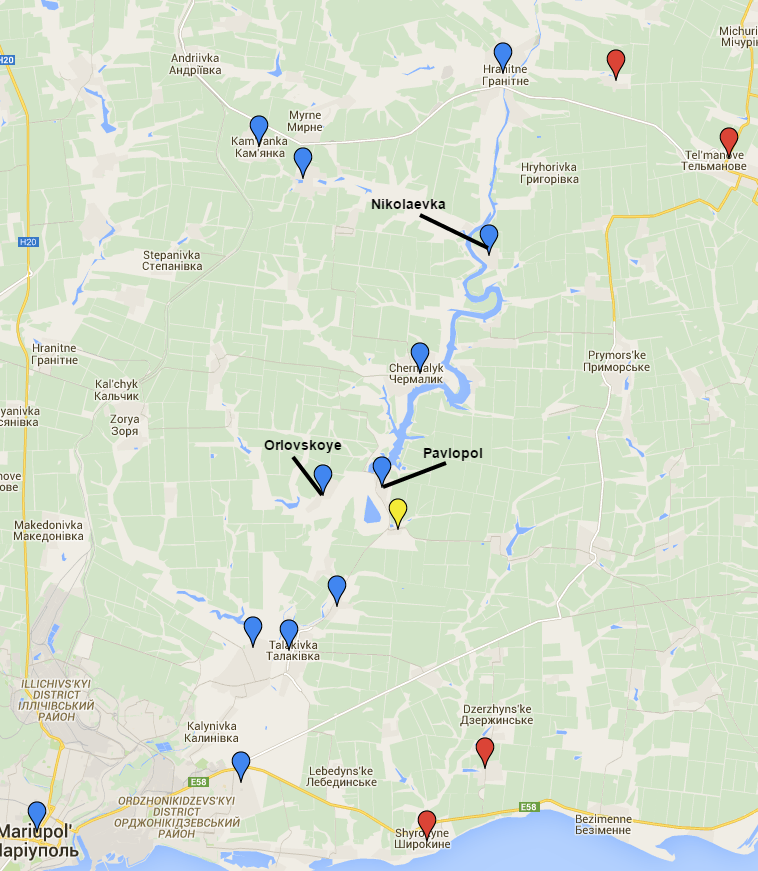
— Pierre Vaux
Vyacheslav Abroskin, the head of the Donetsk regional branch of the Interior Ministry, reported at 9:23 GMT that Avdeyevka, a Ukrainian-held town to the north of Donetsk Airport, was under fire from Russian-backed forces.
The Interpreter translates:
I’m heading to Avdeyevka.
A massive artillery bombardment of the town by the militants is under way. A residential area on Svoboda street has been destroyed. A shell struck the sports hall of School no. 3 and other social sites.
Classes have been suspended in Avdeyevka schools since yesterday.
Translation: Avdeyevka, aftermath of shelling 14/01/15
— Pierre Vaux
With the death toll from Volnovakha, where a bus was struck by shrapnel after a Grad rocket attack, rising to 12, the minimum total of reported civilian casualties yesterday now stands at 20.
In nearby Burgas, another 6 civilians were killed in a Grad attack that coincided with the shelling at the Volnovakha checkpoint.
In Donetsk, where a massive artillery bombardment and assault on Donetsk Airport reached a crescendo in the early evening, accompanied by intense counter-bombardment by Ukrainian forces, one civilian was killed and dozens of houses were destroyed.
And in Granitnoye, to the north-east of Mariupol, near the front line with Russian-backed forces on the Volnovakha-Novoazovsk highway, there were “fatalities” reported by Vyacheslav Abroskin, the head of the Donetsk regional branch of the Interior Ministry.
Abroskin noted that one casualty was a girl of less than three years.
The Interpreter translates:
The militants’ shelling of the village of Granitnoye in the Telmanovo district continues. There are fatalities. In Mariupol, the body of a girl was delivered, 2 and a half years old, with shrapnel wounds to the head.
As Abrosking said “fatalities” but went into no more detail on numbers and described one case, we cannot say more than 20 across the Donetsk region, but the total number of civilian casualties yesterday was likely higher.
The governor of the Donetsk region, Oleksandr Kikhtenko, has declared a day of morning today in the region.
— Pierre Vaux